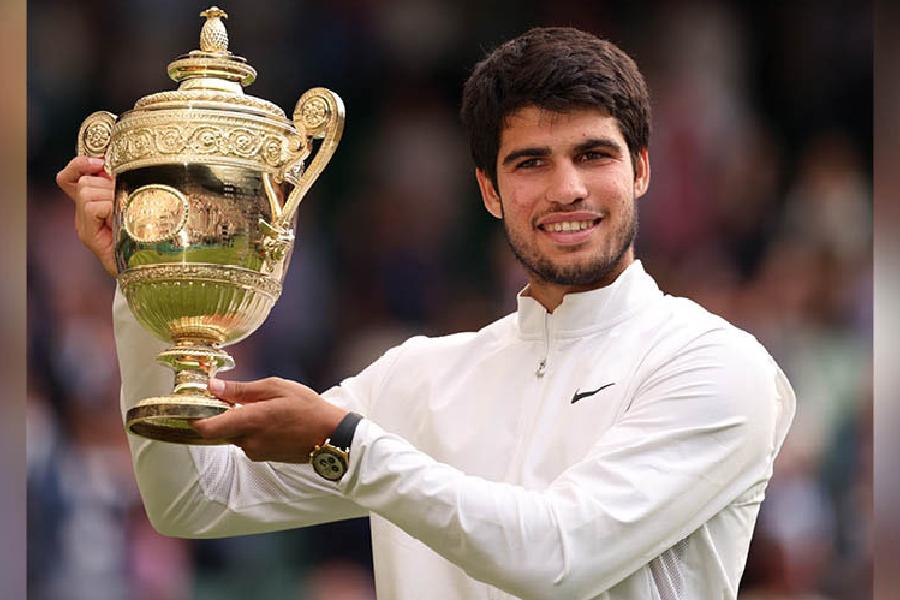Just 20 years old and with two grand slam titles under his belt, Carlos Alcaraz is tipped to make the future of tennis his own. But the young Spaniard has very cleverly brought back into fashion a shot that was getting somewhat lost among the power-ridden ones — the drop shot.
And rather quintessentially, the drop shot has been favoured by many of those who have honed their tennis skills playing in the clubs of Calcutta.
What exactly is a drop shot? It allows the player to get the ball just over the net with an underspin so that it barely bounces, catching the opponent off guard. It is mostly used as a surprise element to suddenly change momentum and make it difficult for the opponent to rush in and execute a return.
Alcaraz, or Carlitos as he likes to be called, has used the forehand drop shot very effectively and with an unusually high frequency on grass, clay and hard courts.
According to an ATP report analysing the past season: “On average, ATP players tend to deploy about 0.85 rally-ending forehand drop shots and 1.05 rally-ending backhand drop shots per match, winning about 51.5% of the points off the forehand drop shot and just 39.7% of the points off the backhand drop shot.
“But not Carlos Alcaraz. The Spanish teen phenom employs the forehand drop shot a breezy 2.83 times per match, with an impressive win rate of 67.7%, and the backhand drop shot at a high 1.34 times per match, with a respectable win rate of 52.1%. This pattern is even more pronounced on clay, where Alcaraz hits 3.81 forehand drop shots per match and 1.84 backhand drop shots per match.”
Alcaraz seems to be carrying on in the same fashion in 2023. On Sunday on the fast and low-bounce grass court at Wimbledon, the shot earned him crucial points against Novak Djokovic on his way to the title.
India’s very own Leander Paes, whose drop shots even impressed Andre Agassi, said: “It can be a very risky shot, but if you practise enough and have the confidence to execute it well, it can be very effective. I used to play drop shots off my backhand. Alcaraz, as you have seen, does it more off his forehand.”
Asked if the coaching tradition and the grass courts that used to be predominant in Calcutta clubs helped him master it, he said: “Perhaps. Many of us did play the drop shot well. I was a serve and volley player and I often used the drop shot after a volley that had my opponent stranded deep at the baseline.”
The supremely talented Alcaraz knows how effective the shot can be. It, of course, helps that he has Juan Carlos Ferrero, a former world No. 1 and French Open champion, as his coach. Ferrero, too, knew how to use the drop shot to surprise his opponents.
Enrico Piperno, former national champion and coach, called the drop shot a “South Club chaalaki (trick)”. “Just yesterday (Sunday) while watching the final this is what we were talking about. The drop shot is a trick, a surprise. (Rafael) Nadal used it against Daniil Medvedev to win the 2022 Australian Open. He must have seen how far back Medvedev was returning from and used that to his advantage. I think Ferrero has guided Alcaraz to see how effective this shot can be. However, am sure he allows him to play his own game. He is supremely talented. When I used to coach Leander and Mahesh (Bhupathi), I knew they would, after all, find their own game plan.
“Also, Alcaraz has the legs to recover and play a shot even if his drop shot goes wrong. So he can take that risk.”
Why do players from Calcutta prefer it? “See, most of us grew up playing on grass and the drop shot helped. Hardly anyone had the speed (except Leander) to come in from the baseline and return it,” Piperno said.
Former Davis Cupper and coach Jaidip Mukerjea, however, feels the shot is too risky. “Even during the final, I feel Alcaraz did lose a couple of points. I would never tell a player to play a drop shot unless he has mastered it. But yes, it is a refreshing change to see such subtle touch among so much power tennis.
“Many of us played it, and played it well. Maybe the grass courts and the fact that it could take the opponent by surprise helped.”
Zeeshan Ali, India’s Davis Cup coach, said: “Unless you have tremendous control and have a very soft touch, it can be a risky shot. I always advise players to avoid it at crucial points. But Alcaraz can afford to do it. He has very good legs and even if his drop shot is returned, he can reach it and play it back. Against Djokovic on Sunday, he must have seen that he was often staying way back beyond the baseline and so used it to earn valuable points. Also, playing drop shots on grass is a good option as the ball doesn’t bounce much.”
Asked about the city’s love for the drop shot, he said: “Mostly because we grew up playing on grass. It was an effective shot on such courts. We automatically learnt how to approach the net.”











